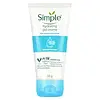What's inside
What's inside
 Key Ingredients
Key Ingredients

 Benefits
Benefits

 Concerns
Concerns

 Ingredients Side-by-side
Ingredients Side-by-side

Water
Skin ConditioningGlycerin
HumectantDicaprylyl Ether
EmollientAlcohol Denat.
AntimicrobialCaprylic/Capric Triglyceride
MaskingZea Mays Starch
AbsorbentPolyglyceryl-3 Methylglucose Distearate
EmulsifyingStearyl Alcohol
EmollientGlyceryl Stearate Se
EmulsifyingCarbomer
Emulsion StabilisingSalicylic Acid
MaskingCaprylyl Glycol
EmollientTocopherol
AntioxidantParfum
MaskingSodium Hydroxide
BufferingXanthan Gum
EmulsifyingSodium Phytate
Glycine Soja Oil
EmollientLinalool
PerfumingMaltodextrin
AbsorbentBenzyl Salicylate
PerfumingCamellia Sinensis Leaf Extract
AntimicrobialLimonene
PerfumingDextrin
AbsorbentBenzyl Alcohol
PerfumingGeraniol
PerfumingWater, Glycerin, Dicaprylyl Ether, Alcohol Denat., Caprylic/Capric Triglyceride, Zea Mays Starch, Polyglyceryl-3 Methylglucose Distearate, Stearyl Alcohol, Glyceryl Stearate Se, Carbomer, Salicylic Acid, Caprylyl Glycol, Tocopherol, Parfum, Sodium Hydroxide, Xanthan Gum, Sodium Phytate, Glycine Soja Oil, Linalool, Maltodextrin, Benzyl Salicylate, Camellia Sinensis Leaf Extract, Limonene, Dextrin, Benzyl Alcohol, Geraniol
Water
Skin ConditioningGlycerin
HumectantDimethicone
EmollientButylene Glycol
HumectantIsohexadecane
EmollientPropylene Glycol
HumectantAmmonium Acryloyldimethyltaurate/Vp Copolymer
Caprylic/Capric Triglyceride
MaskingPhenoxyethanol
PreservativeCaprylyl Glycol
EmollientTocopheryl Acetate
AntioxidantHydrogenated Poly(C6-14 Olefin)
EmollientAmmonium Acryloyldimethyltaurate/Beheneth-25 Methacrylate Crosspolymer
Emulsion StabilisingLinoleamidopropyl Pg-Dimonium Chloride Phosphate
Stearic Acid
CleansingSodium PCA
HumectantDisodium EDTA
BHT
AntioxidantSaccharide Isomerate
HumectantSodium Citrate
BufferingCitric Acid
BufferingPotassium Chloride
Sodium Chloride
MaskingWater, Glycerin, Dimethicone, Butylene Glycol, Isohexadecane, Propylene Glycol, Ammonium Acryloyldimethyltaurate/Vp Copolymer, Caprylic/Capric Triglyceride, Phenoxyethanol, Caprylyl Glycol, Tocopheryl Acetate, Hydrogenated Poly(C6-14 Olefin), Ammonium Acryloyldimethyltaurate/Beheneth-25 Methacrylate Crosspolymer, Linoleamidopropyl Pg-Dimonium Chloride Phosphate, Stearic Acid, Sodium PCA, Disodium EDTA, BHT, Saccharide Isomerate, Sodium Citrate, Citric Acid, Potassium Chloride, Sodium Chloride
 Reviews
Reviews

Ingredients Explained
These ingredients are found in both products.
Ingredients higher up in an ingredient list are typically present in a larger amount.
This ingredient is an emollient, solvent, and texture enhancer. It is considered a skin-softener by helping the skin prevent moisture loss.
It helps thicken a product's formula and makes it easier to spread by dissolving clumping compounds.
Caprylic Triglyceride is made by combining glycerin with coconut oil, forming a clear liquid.
While there is an assumption Caprylic Triglyceride can clog pores due to it being derived from coconut oil, there is no research supporting this.
Learn more about Caprylic/Capric TriglycerideCaprylyl Glycol is a humectant and emollient, meaning it attracts and preserves moisture.
It is a common ingredient in many products, especially those designed to hydrate skin. The primary benefits are retaining moisture, skin softening, and promoting a healthy skin barrier.
Though Caprylyl Glycol is an alcohol derived from fatty acids, it is not the kind that can dry out skin.
This ingredient is also used as a preservative to extend the life of products. It has slight antimicrobial properties.
Learn more about Caprylyl GlycolGlycerin is already naturally found in your skin. It helps moisturize and protect your skin.
A study from 2016 found glycerin to be more effective as a humectant than AHAs and hyaluronic acid.
As a humectant, it helps the skin stay hydrated by pulling moisture to your skin. The low molecular weight of glycerin allows it to pull moisture into the deeper layers of your skin.
Hydrated skin improves your skin barrier; Your skin barrier helps protect against irritants and bacteria.
Glycerin has also been found to have antimicrobial and antiviral properties. Due to these properties, glycerin is often used in wound and burn treatments.
In cosmetics, glycerin is usually derived from plants such as soybean or palm. However, it can also be sourced from animals, such as tallow or animal fat.
This ingredient is organic, colorless, odorless, and non-toxic.
Glycerin is the name for this ingredient in American English. British English uses Glycerol/Glycerine.
Learn more about GlycerinWater. It's the most common cosmetic ingredient of all. You'll usually see it at the top of ingredient lists, meaning that it makes up the largest part of the product.
So why is it so popular? Water most often acts as a solvent - this means that it helps dissolve other ingredients into the formulation.
You'll also recognize water as that liquid we all need to stay alive. If you see this, drink a glass of water. Stay hydrated!
Learn more about Water